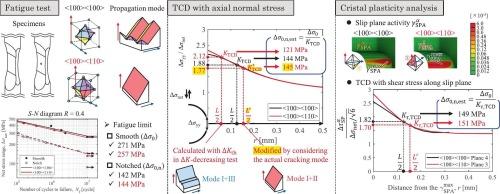Anisotropic fatigue limit estimation for a notched single crystal superalloy based on the theory of critical distances
IF 6.8
2区 材料科学
Q1 ENGINEERING, MECHANICAL
引用次数: 0
Abstract
The notch effect on the high-cycle fatigue strength of the Ni-based single-crystal superalloy CMSX-4 was investigated, focusing on the influence of crystallographic anisotropy. High-cycle fatigue tests were conducted at room temperature on smooth and notched specimens, each with two different secondary crystal orientations. The experimental results for the notched specimens revealed that while their crack initiation sites and propagation paths differed, their fatigue strengths were comparable for the two orientations. Subsequently, finite element analysis was performed on models simulating the notched specimen to predict the experimentally observed fatigue limit based on the theory of critical distances (TCD). It was demonstrated that the anisotropic fatigue limit could be accurately predicted by determining the critical distance based on the observed crack initiation and early propagation modes. This high accuracy was achieved using both the axial normal stress field from an elastic analysis and the shear stress field on the slip plane from a crystal plasticity analysis. The former prediction provides a practical tool for engineering applications, while the latter offers a mechanistically-based rationale for the crystallographic notch effect in fatigue.

基于临界距离理论的缺口单晶高温合金各向异性疲劳极限估计
研究了缺口对ni基单晶高温合金CMSX-4高周疲劳强度的影响,重点研究了其晶体各向异性的影响。在室温下对光滑和缺口试样进行了高周疲劳试验,每个试样都有两种不同的二次晶向。实验结果表明,缺口试样的裂纹起始位置和扩展路径不同,但两种取向的疲劳强度相当。在此基础上,基于临界距离理论,对缺口试件进行有限元模拟,预测试验观察到的疲劳极限。结果表明,根据观察到的裂纹萌生和早期扩展模式确定临界距离,可以准确预测各向异性疲劳极限。这种高精度是通过弹性分析的轴向法向应力场和晶体塑性分析的滑移面上的剪切应力场来实现的。前者的预测为工程应用提供了实用工具,而后者则为疲劳中的晶体缺口效应提供了基于机械的理论基础。
本文章由计算机程序翻译,如有差异,请以英文原文为准。
求助全文
约1分钟内获得全文
求助全文
来源期刊

International Journal of Fatigue
工程技术-材料科学:综合
CiteScore
10.70
自引率
21.70%
发文量
619
审稿时长
58 days
期刊介绍:
Typical subjects discussed in International Journal of Fatigue address:
Novel fatigue testing and characterization methods (new kinds of fatigue tests, critical evaluation of existing methods, in situ measurement of fatigue degradation, non-contact field measurements)
Multiaxial fatigue and complex loading effects of materials and structures, exploring state-of-the-art concepts in degradation under cyclic loading
Fatigue in the very high cycle regime, including failure mode transitions from surface to subsurface, effects of surface treatment, processing, and loading conditions
Modeling (including degradation processes and related driving forces, multiscale/multi-resolution methods, computational hierarchical and concurrent methods for coupled component and material responses, novel methods for notch root analysis, fracture mechanics, damage mechanics, crack growth kinetics, life prediction and durability, and prediction of stochastic fatigue behavior reflecting microstructure and service conditions)
Models for early stages of fatigue crack formation and growth that explicitly consider microstructure and relevant materials science aspects
Understanding the influence or manufacturing and processing route on fatigue degradation, and embedding this understanding in more predictive schemes for mitigation and design against fatigue
Prognosis and damage state awareness (including sensors, monitoring, methodology, interactive control, accelerated methods, data interpretation)
Applications of technologies associated with fatigue and their implications for structural integrity and reliability. This includes issues related to design, operation and maintenance, i.e., life cycle engineering
Smart materials and structures that can sense and mitigate fatigue degradation
Fatigue of devices and structures at small scales, including effects of process route and surfaces/interfaces.
 求助内容:
求助内容: 应助结果提醒方式:
应助结果提醒方式:


